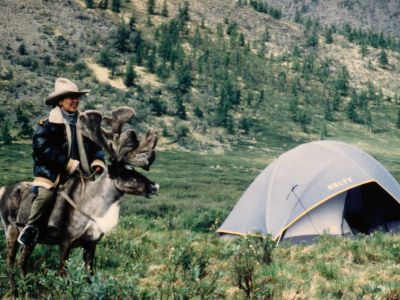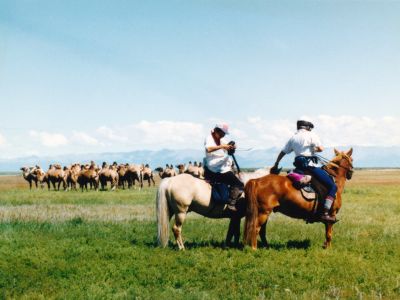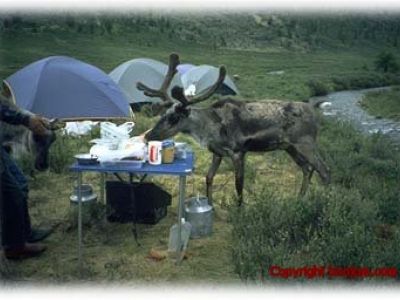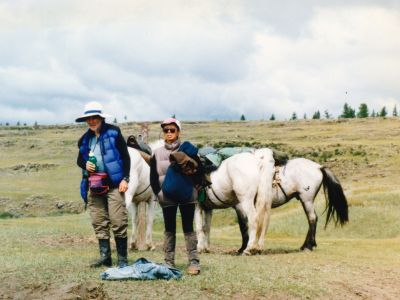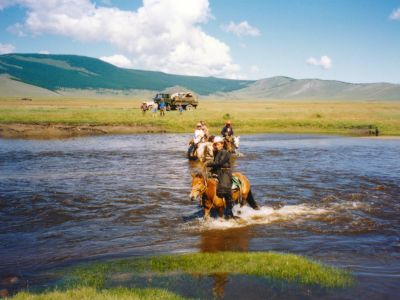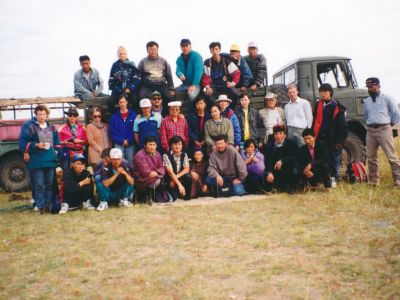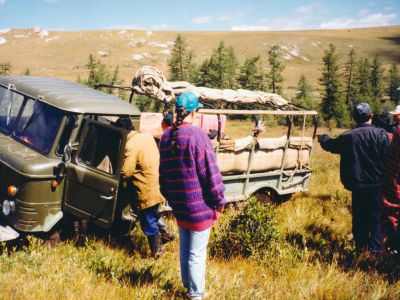About us
Boojum Expeditions has its roots in Boojum Institute, founded in 1975 in San Diego by graduates of Prescott College. Boojum Institute was founded to address the need for experientially based outdoor and environmental education in schools and universities in Southern California.
In 1984, Kent Madin and Linda Svendsen, directors of Boojum Institute, had an opportunity to organize a group of friends to take the first group of tourists to visit the Wolong Panda Reserve (remember Pennies for Pandas?). While on that trip Kent and Linda realized how narrowly the Chinese government defined tourism, largely a matter of herding large groups from meals to museums to shopping to hotels. Kent and Linda plotted with their local guide, Lin Xue Biao, to bring groups to China for adventures: hiking, horseback riding, rafting, cycling.
.jpg)
Forming Boojum Expeditions, Kent and Linda organized the first horseback trek in Inner Mongolia working with the now archaic system of a telex to communicate with Chinese officials in Beijing and Hohhot. During the next decade, they pioneered trips on a horse, foot, mountain bike and raft in China, Tibet, Xinjiang, and Manchuria. In 1985, on the first Inner Mongolia ride, they were married in a traditional Buddhist ceremony.
(Kent and Linda)
During the next decade, Kent and Linda were among the handful of pioneering guides who developed whale watching and sea kayaking trips in Baja California, Mexico.
In 1993 a contingent of Mongolians (Outer Mongolia) visited Bozeman Montana on an exchange program organized by the US State Department. With their interest in Asia, Kent and Linda were invited to be part of the hosting team. From that meeting, Boojum's involvement in Mongolia began. Working via fax (pre-email) they organized a route for a trip to ride horseback to the home of the reindeer people in northern Khovsgol.
Sensing another opportunity, Kent and Linda sought out partners in Mongolia to establish a local tourism company and develop adventure tours by jeep, horseback, foot, camel, and kayak. Starting with a first horseback trek in 1994, Boojum Expeditions now offers a full range of travel experiences in Mongolia, supported by Khovsgol Lodge Management Company, our subsidiary office in Ulaan Baatar founded in 1998. We have full-time local staff in Ulaan Baatar capable or arranging and guiding any trip you can devise.
.jpg)
(Khovsgol Horse Trek – the early 90s)
Along the way, we met good friends and partners in Martin Jones in Argentina and Valeria Ariza in Uruguay and incorporated riding trips into the winter calendar of Boojum Expeditions.
(Valeria Ariza)
Our business plan over the years would make an MBA roll his eyes, but has worked for us. Follow your interests and your instincts, find local individuals who share your eagerness and vision for travel and develop trips which reflect your values. Keep the "adventure" in adventure travel and don't sugar coat things just to make a sale. We treat our clients with respect by telling them what they can expect from Boojum, and what Boojum expects from them. And never diminish the educational and bridge-building aspects of travel by treating it as a commodity. Most of all keep it fun and educational and Uncommon!

The image we use as our logo is a tattoo found on the leg of a Scythian warrior who died over 2,500 years ago. Hundreds of years before the birth of Christ, this tattooed warrior's people had long since tamed the horse and created a nomadic culture based on freedom, mobility, and respect for nature.
His body and his many tattoos were preserved by the frozen ground of the Altai Mountains which border modern-day Mongolia and Siberia. He had died in combat, his skull pierced by a battle ax. He was buried wearing a full-length marmot skin coat and alongside him in the grave, laid out with his weapons and possessions, were two stallions wearing bridles decorated with gold.
The creature depicted is most likely a snow leopard, the distinctive ringed tail and the feline body makes that our best guess. While snow leopards are now extremely rare, due to hunting and the reduction of their habitat, they surely were important to the early nomads of Central Asia; a predator and traveler of similar cunning and skill.
The Scythians are a people lost in the dusk of time, forerunners to the "modern" Mongol empire constructed by Genghis Khan. The Scythes left little in the way of written records and their tombs are our best window on their culture. They were, without dispute, masters of the steppe moving with their "fields on the hoof", hunting, gathering and along the way, finding time to create spectacular artwork indelibly etched on their own bodies.
In his epic poem, "The Hunting of the Snark", Lewis Carroll (of Alice in Wonderland fame) describes an eclectic band of travelers in search of the elusive Snark. The Boojum, a spectral, mystical Snark alter-ego figures prominently in the poem, but is only vaguely described or illustrated. The poem cautions how one may "softly and suddenly vanish away" on encountering a Boojum.
.jpg)
Half a century later, an English botanist and aficionado of Carroll saw the strange Idria Columnaris tree, unique to Baja California and dubbed it a "Boojum". When we began our adventure careers over 20 years ago many of our trips took place in Baja California and we adopted the intriguing name, for better or for worse.
A Boojum is also a subatomic particle from the more rarified realms of quantum physics and a Google search will reveal it to be the name of choice for cats, dogs, the occasional sailboat, a restaurant, a musical play, a search engine in the service of Jesus and some sort of a Celtic/Wiccan sword dancing troop in England "whose the only reason for doing this is "... in order to party".
The spirit of the Boojum is indefatigable.
The name has grown on us. It's from a poem about an eclectic group of travelers, it's distinctive and it has just the right touch of whimsy which keeps with our conviction that a sense of humor is the key element in a safe and fulfilling travel experience. But, don't forget your passport.
.jpg)



.jpg)
